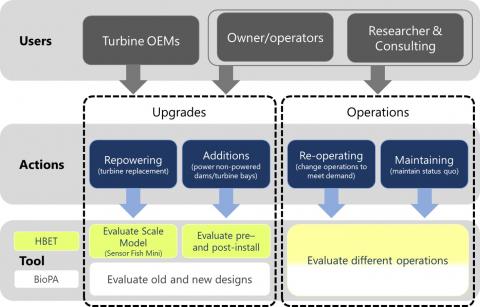Applications
HydroPASSAGE tools and technologies have been applied in several different cases to provide information to guide hydropower operations. These tools are designed to assist hydropower owners and operators, turbine original equipment manufacturers, researchers and consultants in evaluating the biological performance of turbines in support of four main actions—Repowering, Additions, Re-operating, and Maintaining. The link between HydroPASSAGE tools, intended users, and actions that the tools support is demonstrated in the figure below.

Featured Applications of HydroPASSAGE Tools
BioPA
Action: Repowering
Location: Priest Rapids Dam (Columbia River, Washington, USA)
Need: Grant County Public Utility District (GCPUD) operates Priest Rapids Dam, a hydroelectric facility on the Columbia River in Washington State. The dam contains ten Kaplan style turbines that are over 50 years old. GCPUD is retrofitting this facility with new hydroturbines to increase power production efficiency and extend the life of the plant. However, the Columbia River at Priest Rapids Dam is a major migratory pathway for juvenile and adult salmonids, many species of which are threatened or endangered. Therefore, ensuring continued safe fish passage through the dam is a key consideration for turbine replacement.
Approach: GCPUD used BioPA to calculate baseline risk assessments of the existing Kaplan hydropower turbines to determine the minimum biological performance that a proposed new design must achieve. BioPA was used to estimate the relative probability of exposure to pressure change, blade strike, and hydraulic shear and turbulence for the proposed hydropower turbine designs. The application was coupled with the probability of injury or mortality for juvenile Chinook salmon using information collected from laboratory studies. BioPA was provided to the three hydropower turbine manufacturers that are competing for the turbine upgrade contract.
Benefit and Problem Solved: Using BioPA allowed Grant County to compare turbine designs and evaluate their biological performance without the need for reduced-scale physical models to assess biological performance, saving both time and money during the turbine refit process. The application of BioPA provided a design point goal and helped to select an improved turbine design that will help ensure the safety of fish passing through these structures at Priest Rapids Dam.
HBET & Sensor Fish
Action: Additions
Location: Nam Ngum Dam (Mekong River, Laos)
Need: The Mekong River, located in Southeast Asia, has a stunning array of biodiversity that includes over 900 fish species. In the coming decades, there are plans for many new hydropower projects in the area. However, the fish passage needs and potential impacts of proposed and planned hydropower projects on local fish species of concern is poorly understood. This type of evaluation provides information that enables better predictions of how hydropower development will impact native fish species. The study below is a beginning to this type of evaluation in the region.
Approach: HBET and the Sensor Fish were deployed at Nam Ngum Dam to characterize the hydraulic conditions and to estimate the probability of injury and mortality of fish travelling through existing hydropower facilities. Understanding the hydraulic and fish passage conditions at existing hydropower facilities will help to guide the design of hydropower turbines and operating conditions that will mitigate the environmental impact of these projects to provide safe fish passage.
Benefit and Problem Solved: This study demonstrated that newer hydropower turbines, with increased efficiency and power production, also had better conditions for fish passage. With a solid understanding of the current hydraulic conditions and biological performance in existing hydropower facilities, decisions regarding project design and operation can be better informed. This is especially important for the development of new sustainable hydropower projects.
HBET & Sensor Fish
Action: Re-operating
Location: Boundary Dam (Pend Orielle River, Washington USA)
Need: Engineering modifications were made to the spillway at Boundary Dam in order to decrease the amount of total dissolved gas in the water and improve fish passage conditions. However, the impact that these modifications had on the jet flow and other stressors that could impact fish passage (e.g. shear, blade strike) needed to be evaluated after the modifications were completed.
Approach: Prior to design modifications, Sensor Fish and HBET were deployed to establish baseline conditions including high flows and estimates of fish injury and mortality. After the modifications were completed, Sensor Fish and HBET were used to assess the changes would have on fish passage conditions.
Benefit and Problem Solved: Sensor Fish and HBET were able to confirm that design modifications had the intended effect of reducing jet flows and therefore improving fish passage conditions. This information can be used to help guide design and operational changes of spillways for improving fish passage conditions. Additionally, this information was used for validation of computational fluid dynamics modeling.